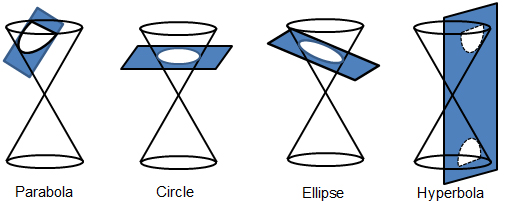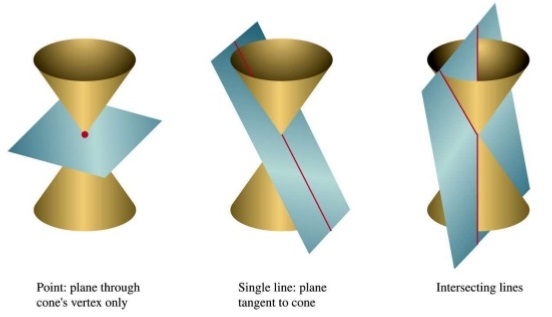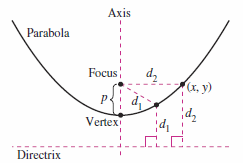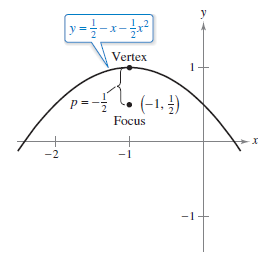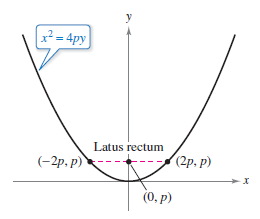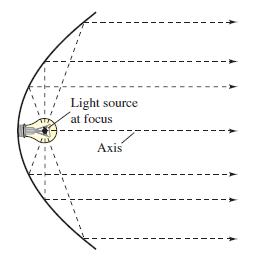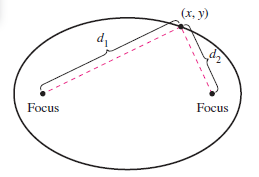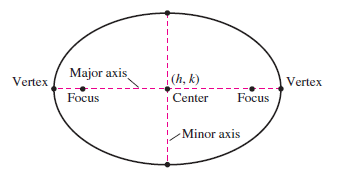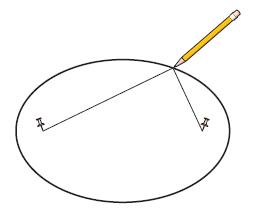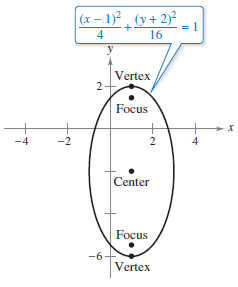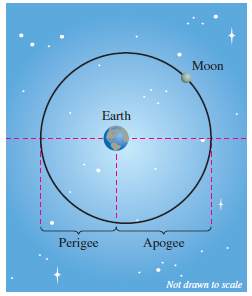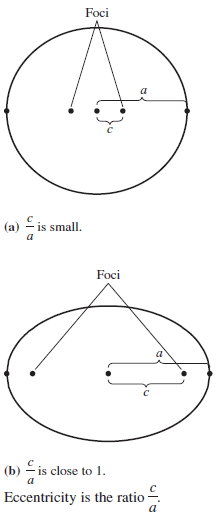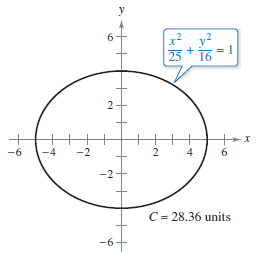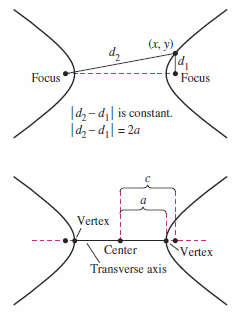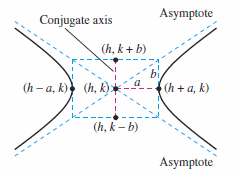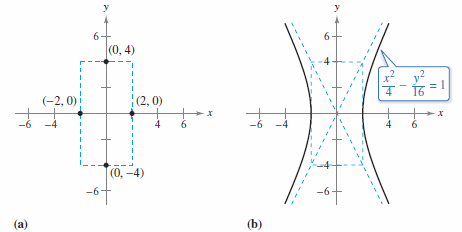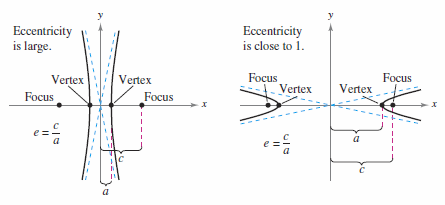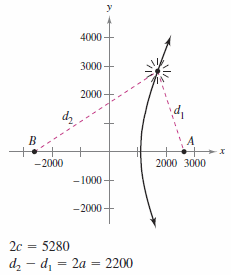Calculus II 10.01 Conics and Calculus
| Previous | Calculus II 09 Infinite Series |
| Next | Calculus II 10.02 Plane Curves and Parametric Equations |
Contents
- 1 10.1 Conics and Calculus[1]
- 1.1 Conic Sections
- 1.2 Parabolas
- 1.3 Ellipses[2]
- 1.3.1 Theorem 10.1.3 Ellipse Standard Equation
- 1.3.2 Example 10.1.3 Focal Chord Length and Arc Length
- 1.3.3 Example 10.1.4 The Moon's Orbit
- 1.3.4 Theorem 10.1.4 Ellipse Reflective Property
- 1.3.5 Definition 10.1.1 Ellipse Eccentricity
- 1.3.6 Example 10.1.5 Finding an Ellipse's circumference
- 1.3.7 Example 10.1.6 Elliptic Integral Approximation
- 1.4 Hyperbolas[3]
- 2 Internal Links
10.1 Conics and Calculus[1]
- Conic section definition
- Parabolas equations
- Ellipses equations
- Hyperbolas equations
Conic Sections
Each conic section (or simply conic) can be described as intersecting a plane through a double-napped cone. Notice in Figure 10.1.1 that for the four basic conics, circle, parabolas, ellipses, and hyperbolas, the intersecting plane does not pass through the cone's vertex. When the plane passes through the vertex, the resulting figure is a degenerate conic, as shown in Figure 10.1.2.
There are several ways to study conics. The Ancient Greeks defined conics as planes and cones intersecting. As shown in Figures 10.1.1 and 10.1.2. It can also be defined algebraically in as a general second-degree equation.
- $$ Ax^{2}+Bxy+Cy^{2}+Dx+Ey+F=0 \:\:\:\: \color{red}{\text{General second-degree equation }}$$
A third approach defines conics as a locus (point set) that satisfying a certain geometric property, works best with calculus. For example, a circle can be defined as a point set \((x,y)\) where all points that are equidistant from a fixed point \((h,k)\), the center. This locus definition easily produces the standard equation for a circle.
- $$ (x-h)^{2}+(y-k)^{2}=r^{2} \:\:\:\: \color{red}{\text{Standard equation for a circle}}$$
Parabolas
|
|
A parabola is a point set \((x,y)\) where each point pair are equidistant from a fixed line, the directrix, and a fixed point, the focus, not on the line. The midpoint between the focus and the directrix is the vertex, and the line passing through the focus and the vertex is the parabola's axis. Note in Figure 10.1.3 that a parabola is symmetric with respect to its axis. |
Theorem 10.1.1 Parabola Standard Equation
The standard form for a parabola's equation with the vertex at \((h,k)\) and directrix \(y=k-p\) is
- $$(x-h)^{2}=4p(y-k) \:\:\:\: \color{red}{\text{ Vertical axis}}$$
For directrix \(x=h-p\), the equation is
- $$(y-k)^{2}=4p(x-h) \:\:\:\: \color{red}{\text{ Horizontal axis}}$$
The focus lies on the axis \(p\) units, directed distance, from the vertex. The coordinates for the focus are as follows.
- $$(h,k+p) \:\:\:\: \color{red}{\text{ Vertical axis}}$$
- $$(h+p,k) \:\:\:\: \color{red}{\text{ Horizontal axis}}$$
Example 10.1.1 Finding a Parabola's Focus
|
|
Find the focus for the parabola
Solution To find the focus, convert to standard form by completing the square.
Comparing this equation with
yields
Because \(p\) is negative the parabola opens downward, as shown in Figure 10.1.4. The parabola's focus is \(p\) units from the vertex.
|
Example 10.1.2 Focal Chord Length and Arc Length
|
|
A line segment that passes through a parabola's focus and has endpoints on the parabola is called a focal chord. A focal chord perpendicular to the parabola's axis is called a latus rectum. Find the length for the parabola's latus rectum.
Then find the length for the parabolic arc intercepted by the latus rectum.
Substituting \(p\) for \(y\) in the equation produces
The latus rectum endpoints are \((-2p,p)\) and \((2p,p)\), and its length is \(4p\), as shown in Figure 10.1.5. The intercepted arc's length is found using the arc length formula.
|
|
|
The parabola reflective property is widely used in optics and lighting. In physics, a surface is called reflective when the tangent line at any point on the surface makes equal angles with an incoming ray and the resulting outgoing ray. The angle corresponding to the incoming ray is the incidence angle, and the angle corresponding to the outgoing ray is the reflection angle. A mirror formed by revolving a parabola about its axis has the property that all incoming rays parallel to the axis are directed through the parabola's focus. This is how the parabolic mirrors used in reflecting telescopes are designed. Conversely, all light rays emanating from the focus of a parabolic reflector used in a flashlight are parallel, as shown in Figure 10.1.6. |
Theorem 10.1.2 Parabola Reflective Property
Let \(P\) be a point on a parabola. The tangent line to the parabola at point \(P\) makes equal angles with the following two lines.
- The line passing through \(P\) and the focus
- The line passing through \(P\) parallel to the parabola's axis
Ellipses[2]
An ellipse is an elongated circle with two special points called foci' along an axis that goes through the ellipses' center. This chord is called the major axis and its midpoint is the ellipses' center. The sum for the distances from any point, \((x,y)\), along the ellipse from both foci is constant and equal to the major axis length. See Figure 10.1.7. The line through the foci intersects the ellipse at two points, called the vertices. The chord perpendicular to the major axis at the center is the ellipses' minor axis. See Figure 10.1.8.
Theorem 10.1.3 Ellipse Standard Equation
|
|
The equation for an ellipse with center \((h,k)\) and major and minor axes with lengths \(2a\) and \(2b\), where \(a>b\), is
or
The foci lie on the major axis, \(c\) units from the center, with
An ellipse can be drawn by sticking two thumbtacks into a board, tie string between them, and tracing the outline with a pencil as shown in Figure 10.1.9. |
Example 10.1.3 Focal Chord Length and Arc Length
|
|
Find the center, vertices, and foci for the ellipse
Solution By completing the square the original equation can be written in standard form.
The major axis is parallel to the \(y\)-axis, where \(h=1,\:k=-2,\:a=4,\:b=2,\text{ and } c=\sqrt{16-4}=2\sqrt{3}\). This produces
The ellipses graph is shown in Figure 10.1.10. |
Example 10.1.4 The Moon's Orbit
|
|
The moon orbits Earth in an elliptical path with Earth's center at one focus, as shown in Figure 10.1.11. The major axis is 768,800 kilometers and the minor axis is 767,640 kilometers. Find the greatest and least distances (the apogee and perigee) from Earth’s center to the moon’s center.
Using these values the solution for \(c\) is
The greatest distance between the Earth and Moon is
The least distance is
|
Theorem 10.1.4 Ellipse Reflective Property
Let \(P\) be a point on an ellipse. The tangent line to the ellipse at point \(P\) makes equal angles with the lines through \(P\) and the foci.
The inner planets, Mercury, Venus, Earth, and Mars, are so near the Sun their orbits are nearly circular. This made it difficult for early astronomers to detect that the orbits were elliptical and not circular. An ellipse eccentricity describes how oval or circular it is.
Definition 10.1.1 Ellipse Eccentricity
|
|
The eccentricity \(e\) for an ellipse is given by the ratio
Because the foci are along the major axis between the vertices and center
For an ellipse that is nearly circular, the foci are close to the center and the ratio \(c/a\) is close to 0. For an elongated ellipse, the foci are close to the vertices and the ratio \(c/a\) is close to 1, as shown in Figure 10.1.12. Note that
for every ellipse. The Moon's orbit the eccentricity \(e \approx 0.0549\). The orbital eccentricities for the eight planets are listed in Table 10.1.1.
| ||||||||||||||||||||||||
An ellipse's area is \(A=\pi ab\), and can be found using integration. For example, The ellipse
- $$ \frac{x^{2}}{a^{2}} + \frac{y^{2}}{b^{2}}=1 $$
has the area
| $$A$$ | $$=4 \int_{0}^{a} \frac{b}{a} \sqrt{a^{2}-x^{2}}\: dx $$ | |
| $$= \frac{4b}{a} \int_{0}^{\pi /2} a^{2} \cos^{2} \theta \: d\theta.$$ | \( \color{red}{ \text{Trigonometric substitution }x=a \sin \theta} \) |
Example 10.1.5 Finding an Ellipse's circumference
The next example shows how to use to set up an “elliptic integral” for the circumference of an ellipse. Use eccentricity to show that the circumference for the ellipse
- $$ \frac{x^{2}}{a^{2}} + \frac{y^{2}}{b^{2}}=1 $$
is $$ 4a \int_{0}^{\pi /2} \sqrt{1-e^{2} \sin^{2} \theta} \: d\theta \:\:\:\: \color{red}{ e=\frac{c}{a}} $$ Solution Because the ellipse is symmetric with respect to the \(x\) and \(y\) axes its circumference \(C\) is four times the arc length
- $$ y= \frac{b}{a} \sqrt{a^{2}-x^{2}} $$
in the first quadrant. The function \(y\) is differentiable for all \(x\) on the interval \([0,a]\) except at \(x=a\). The circumference is given by the improper integral
- $$ C= \lim_{d \to a^{-}} 4 \int_{0}^{d} \sqrt{1+(y{}^{\prime })^{2}} \:dx = 4 \int_{0}^{a} \sqrt{1+(y{}^{\prime })^{2}} \:dx = 4 \int_{0}^{a} \sqrt{1+ \frac{b^{2}x^{2}}{a^{2}(a^{2}-x^{2})}} \:dx. $$
Using trigonometric substitution \(x=a \sin \theta\), yields
| $$C$$ | $$=4 \int_{0}^{ \pi /2} \sqrt{1+ \frac{b^{2} \sin^{2} \theta}{a^{2}\cos^{2} \theta}}(a \cos \theta ) \:d\theta $$ |
| $$= 4 \int_{0}^{ \pi /2} \sqrt{ a^{2}(1-\sin^{2} \theta) + b^{2} \sin^{2} \theta } \:d\theta $$ | |
| $$= 4 \int_{0}^{ \pi /2} \sqrt{ a^{2}-(a^{2} -b^{2}) \sin^{2} \theta } \:d\theta $$ |
Because
- $$ e^{2} = \frac{c^{2}}{a^{2}} = \frac{(a^{2}-b^{2})}{a^{2}}$$
the integral can be written as
- $$C= 4a \int_{0}^{ \pi /2} \sqrt{ 1-e^{2}\sin^{2} \theta} \:d\theta $$
Example 10.1.6 Elliptic Integral Approximation
|
|
Elliptic integrals generally do not have elementary antiderivatives. To find the circumference usually requires an approximation technique. Use the elliptic integral in Example 10.1.5 to approximate the circumference for the ellipse.
Solution Because
implies
Applying Simpson’s Rule with \(n=4\) produces
|
Hyperbolas[3]
|
|
A hyperbola is an open curve with two branches caused by a plane intersecting a double cone through both halves. See Figure 10.1.1. The plane does not have to be parallel to the cone's axis, the hyperbola is always symmetrical in any case. Graphically, a hyperbola is two parabolas facing each other. This gives the graph two separate branches. Hyperbola and ellipses share foci, vertices and a center. Any point on the hyperbola, \((x,y)\), is the absolute distance between that point and the foci. See Figure 10.1.14. The line segment connecting the vertices is the transverse axis, major axis, and its midpoint is the center. Theorem 10.1.5 Hyperbola Standard EquationA hyperbola with the center at \((h,k)\) is described by the equation
or
The vertices are \(a\) units from the center, and the foci are \(c\) units from the center, where \(c^{2}=a^{2}+b^{2}\). Note that the constants \(a\), \(b\), and \(c\) do not have the same relationship for hyperbolas as they do for ellipses. For hyperbolas, \(c^{2}=a^{2}+b^{2}\), but for ellipses, \(c^{2}=a^{2}-b^{2}\). An important aid in sketching an hyperbola is determining its asymptotes, as shown in Figure 10.1.15. Each hyperbola has two asymptotes that intersect at the center. The asymptotes pass through an imaginary rectangle with dimensions \(2a\) by \(2b\) with its center at \((h,k)\). The line segment with length \(2b\) joining
and
is referred to as the conjugate axis for the hyperbola. |
Theorem 10.1.6 Hyperbola Asymptotes
For a horizontal transverse axis, the asymptotes are
- $$y=k+ \frac{b}{a}(x-h) \text{ and } y=k- \frac{b}{a}(x-h) $$
For a vertical transverse axis, the asymptotes are
- $$y=k+ \frac{a}{b}(x-h) \text{ and } y=k- \frac{a}{b}(x-h) $$
Example 10.1.7 Using Asymptotes to Sketch a Hyperbola
Sketch the graph for the hyperbola
- \(4x^{2}-y^{2}=16 \)
Solution Begin by rewriting the equation in standard form.
- $$\frac{x^{2}}{4} - \frac{y^{2}}{16}=1$$
The transverse axis is horizontal and the vertices occur at (-2,0) and (2,0). The conjugate axes ends are (0,-4) and (0,4). Using these four point the rectangle can be sketched as shown in Figure 10.1.16(a). By drawing the asymptotes through the corners the sketch is completed as shown in Figure 10.1.16(b).
Definition 10.1.2 Hyperbola Eccentricity
The eccentricity \(e\) for a hyperbola is given by the ratio.
- $$e=\frac{c}{a}$$
The eccentricity is the same for ellipses and hyperbolas. Because \(c>a\) for hyperbolas it follows that \(e>1\) for hyperbolas. If the eccentricity is large the branches are nearly flat. If the eccentricity is close to 1 the branches are more pointed as shown in Figure 10.1.17.
Example 10.1.8 A Hyperbolic Detection System
|
|
Hyperbolas were used to create radar and sound detection systems during WWII. Two microphones, 1 mile apart, record an explosion. Microphone \(A\) receives the sound 2 seconds before microphone \(B\). Where was the explosion?
where
and
Because \(c^{2}=a^{2}+b^{2}\), it follows that
Back substituting places the explosion on the hyperbola's right branch at
This answer gives a distance and branch, but not the exact location. A third sensor, say \(C\), would provide enough information for two more hyperbolas and thus allow us to triangulate the exact position. |
Internal Links
Parent Article: Calculus II 10 Conics Parametric Equations and Polar Coordinates
